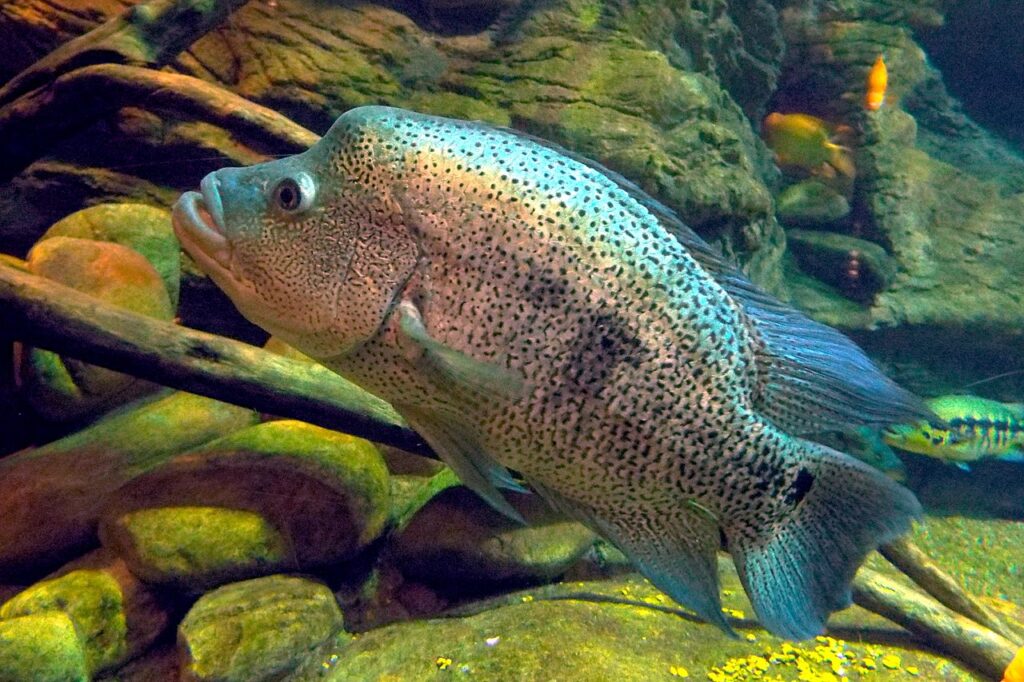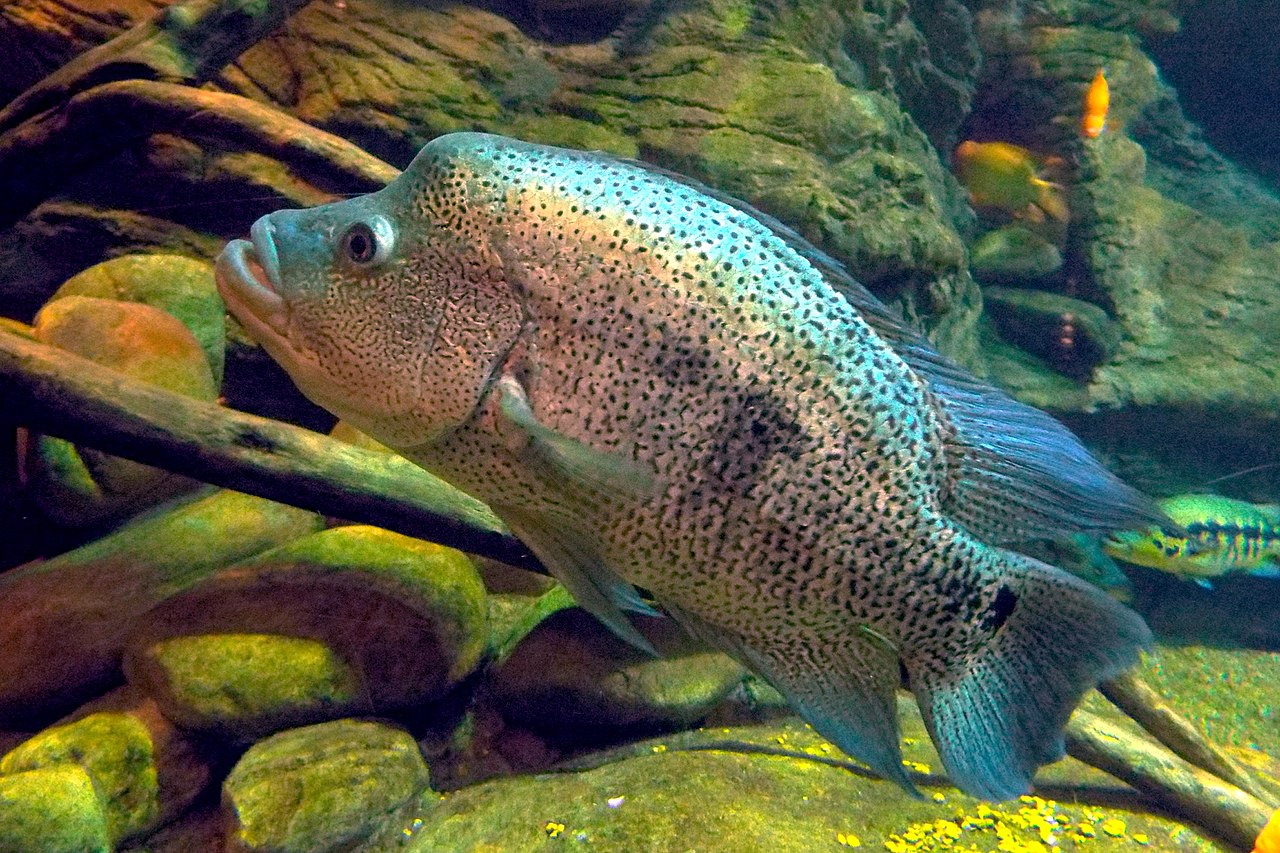If you’re an experienced aquarist looking for a challenging but rewarding addition to your tank, the Wolf Cichlid, scientifically known as Parachromis dovii, might just be the fish for you. This fascinating creature hails from the Cichlidae family and is closely related to other popular cichlids like the Jack Dempsey and Oscars. Sporting a colorful palette of blues, greens, yellows, and reds, it’s a visual delight, but not without its quirks.
Table of Contents
Let’s start with some interesting facts about the Wolf Cichlid. Did you know that they can recognize their owners? Also, despite their aggressive tendencies, they make attentive parents. Speaking of aggression, this fish is not your usual community tank dweller. They are known for their territorial and aggressive nature, especially during breeding seasons. Because of this, they are often kept alone or with a very limited number of tank mates.
The fish isn’t exceptionally rare but isn’t as commonly found as other cichlids either. Some enthusiasts have even trained their Wolf Cichlids to perform simple tricks, adding a fun aspect to their care. While they don’t have recognized variants, different color morphs do exist, likely due to their diverse natural habitats or selective breeding.
Regarding their natural habitat, they primarily inhabit lakes and rivers in Central America. In the water column, they are primarily bottom to mid-dwellers. Their diet is predominantly carnivorous, consisting of live or frozen foods like shrimp, fish, and occasionally, insects. It’s crucial to keep these diet preferences in mind for their well-being.
In terms of their size and lifespan, these fish can grow up to 28 inches in the wild but are generally smaller in captivity. They have a lifespan of 10-15 years and thrive in water conditions with a pH level between 7 and 8, and temperatures ranging from 75-81°F. A tank of at least 125 gallons is recommended for a single adult due to their territorial behavior.
The Wolf Cichlid was first described in 1864 by the ichthyologist Albert Günther. Since then, it has captivated the interest of cichlid enthusiasts and scientists alike. It is often a subject in various biological and ecological studies, partly because of its complex behaviors and specific habitat needs. For those interested in delving deeper, you can refer to reputable scientific journals focusing on the Wolf Cichlid and its intriguing lifestyle.
Owning a Wolf Cichlid can be a complex but rewarding experience. It’s a fish that demands your attention and care but gives back in the form of its beauty, intelligence, and unique behaviors. If you’re up for the challenge, the Wolf Cichlid is a captivating creature that promises an engaging but demanding fishkeeping journey.

Key Information
Wolf Cichlids are fascinating creatures, not just for their vibrant colors and intriguing behaviors but also for their unique characteristics. While there aren’t officially recognized variants, enthusiasts have noted different color morphs likely resulting from their diverse natural habitats or selective breeding. In this table, we delve deeper into various aspects of Wolf Cichlid care, from water parameters to ideal tank mates.
| Family | Cichlidae |
| Price | Varies, generally more expensive than common cichlids |
| Common Names | Wolf Cichlid, Dovii |
| Variants | No recognized variants; color morphs exist |
| Ideal Tank Size | At least 125 gallons for a single adult |
| Water Parameters | pH 7-8, Temperature 75-81°F |
| Lifespan | 10-15 years |
| Full Size | Up to 28 inches in the wild; smaller in captivity |
| Natural Environment | Lakes and rivers in Central America |
| Behavior | Aggressive, territorial, especially during breeding |
| Habitat Preference | Bottom to mid-dwellers |
| Aquarium Decoration | Rocks, driftwood, and plants for hiding spots |
| Ideal Tank Mates | Very limited due to aggressive nature; larger cichlids |
| Fish to Avoid | Small fish, less aggressive species |
| Best Foods/Diet | Carnivorous: live or frozen shrimp, fish, occasional insects |
| Disease | Susceptible to common fish diseases like Ich |
| Sex-Switch | No known sex-switching behavior |
| Gender Differences | Males are generally larger and more colorful |
| Care Level | High; not for beginners |
| Breeding Level | Moderate to Difficult; require specific care during breeding |
Ideal Tank Mates
Finding the ideal tank mates for a Wolf Cichlid is a challenging task. Due to their aggressive and territorial nature, Wolf Cichlids are not well-suited for community tanks with smaller or less aggressive fish. However, for experienced aquarists looking to create a more dynamic environment, there are some options to consider. The key is to choose fish that can hold their own against the Wolf Cichlid and are also compatible in terms of water parameters and diet. Larger cichlids, catfish, and other robust fish species are often good candidates.
1. Jack Dempsey (Rocio octofasciata)
Jack Dempseys are similar in temperament to Wolf Cichlids. Their aggressive nature makes them capable of defending themselves, and they share similar water and dietary requirements.
2. Oscar (Astronotus ocellatus)
Oscars are another cichlid species that can hold their own. They are large and have a similar level of aggression, making them a suitable tank mate.
3. Texas Cichlid (Herichthys cyanoguttatus)
Texas Cichlids are robust and can handle the aggressive behavior of a Wolf Cichlid. They also share similar water conditions and diets.
4. Green Terror (Andinoacara rivulatus)
Like the Wolf Cichlid, Green Terrors are known for their aggressive behavior, making them capable of defending themselves in a shared environment.
5. Jaguar Cichlid (Parachromis managuensis)
Jaguar Cichlids are closely related to the Wolf Cichlid and have similar care requirements. Their aggressive nature makes them a compatible choice.
6. Clown Loach (Chromobotia macracanthus)
Clown Loaches are bottom-dwellers like the Wolf Cichlid and can handle similar water parameters. However, they are best suited for larger tanks.
7. Convict Cichlid (Amatitlania nigrofasciata)
Convict Cichlids are smaller but have a feisty nature that allows them to coexist with more aggressive species like the Wolf Cichlid.
8. Plecostomus (Hypostomus plecostomus)
Plecostomus are bottom-feeders that generally keep to themselves, making them less likely to engage in territorial disputes with the Wolf Cichlid.
9. Firemouth Cichlid (Thorichthys meeki)
Firemouth Cichlids are territorial but generally peaceful. They can coexist with Wolf Cichlids in a sufficiently large and well-decorated tank.
10. African Cichlids
Some species of African Cichlids can hold their own against a Wolf Cichlid due to their aggressive behavior and similar water requirements.
11. Bichirs (Polypterus species)
Bichirs are hardy fish that dwell at the bottom of the tank. They are large enough not to be seen as prey by the Wolf Cichlid.
12. Black Ghost Knifefish (Apteronotus albifrons)
This species is generally peaceful but can grow large enough to not be threatened by the Wolf Cichlid, given adequate hiding spots.
13. Arowana (Osteoglossidae)
Arowanas are top-dwellers and will generally stay out of the Wolf Cichlid’s territory. They are large and can hold their own.
14. Synodontis Catfish (Synodontis spp.)
These are bottom-dwelling catfish that are generally good at avoiding conflict. Their hardy nature makes them a compatible choice.
15. Redtail Catfish (Phractocephalus hemioliopterus)
Redtail Catfish are large and robust, capable of handling themselves around a Wolf Cichlid. They also have similar care requirements.
It’s important to note that even with these ‘compatible’ tank mates, caution should be exercised. The tank environment, size, and decorations can play a significant role in how well these species coexist. Always monitor the tank closely when introducing new fish to ensure that aggression is kept to a manageable level.
FAQs
While we’ve covered a broad range of topics about the Wolf Cichlid, you may still have some questions that haven’t been addressed. Here are some frequently asked questions that delve into other aspects of Wolf Cichlid care and characteristics that haven’t been discussed earlier.
Can Wolf Cichlids Be Kept in Brackish Water?
No, Wolf Cichlids are freshwater fish and are not suited for brackish water conditions. They require specific pH levels and water temperatures, as mentioned in earlier sections.
Do Wolf Cichlids Require Special Lighting?
Wolf Cichlids don’t have specific lighting requirements. Standard aquarium lighting that mimics a natural day-night cycle is sufficient for them.
Can They Be Kept with Invertebrates?
It’s not recommended to keep Wolf Cichlids with invertebrates like shrimp or snails, as they are likely to become a meal for the Wolf Cichlid given its carnivorous nature.
What Are the Signs of Stress in Wolf Cichlids?
Signs of stress can include faded coloration, decreased appetite, and erratic swimming behavior. These signs may indicate an issue with water quality, illness, or issues with tank mates.
Is a Heater Necessary for the Wolf Cichlid’s Tank?
Yes, a heater is generally recommended to maintain the water temperature within the ideal range for Wolf Cichlids, especially if you’re keeping them in a climate that experiences temperature fluctuations.
How Do Wolf Cichlids React to Aquatic Plants?
Wolf Cichlids may dig and rearrange the substrate, which can uproot aquatic plants. Therefore, it’s advisable to either avoid plants or opt for hardy, well-anchored species.
Are Wolf Cichlids Sensitive to Medication?
Like many other fish, Wolf Cichlids can be sensitive to certain medications, especially those containing copper. Always consult an expert or veterinarian before administering any medication.
Can Wolf Cichlids Be Trained?
While not officially documented, some aquarists have claimed to train their Wolf Cichlids to perform simple tricks. However, this is not a widespread practice and should be approached with caution.
Do Wolf Cichlids Make Sounds?
Fish don’t make sounds in the way mammals do, but some aquarists report clicking or grunting noises during aggressive displays or feeding. The scientific community is still studying these behaviors.
What Are Their Predators in the Wild?
In their natural habitat, Wolf Cichlids face threats from larger predatory fish and birds. However, due to their size and aggressive nature, adult Wolf Cichlids have fewer natural predators compared to juveniles.

Leave a Reply